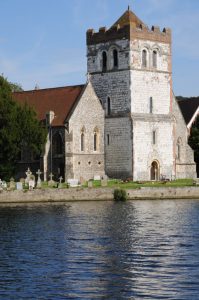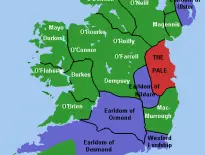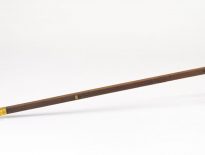Today is the anniversary of the death, on 13th July 1566, of Sir Thomas Hoby, diplomat, courtier and translator, at Paris. Hoby was buried in All Saints Church, Bisham.
Hoby was the second son of William Hoby of Radnor and his wife, Katherine Forden, and he was born at Leominster in Herefordshire in 1530. He was educated at St John's College, Cambridge, matriculating in May 1545. Between 1545 and 1547 he studied under the famous Tudor scholar John Cheke but in August 1547, heeding the advice of his half-brother, Sir Philip Hoby, he left Cambridge without obtaining a degree and set off for the Continent. His Oxford Dictionary of National Biography biographer writes of how he studied classics and theology for nearly a year in Strasbourg as the guest of reformer Martin Bucer.
He was back in England by Christmas 1550 when he was introduced at the court of Mary I, but then spent most of the queen's reign abroad due to his Protestant faith. In May 1558, his half-brother died and he inherited Bisham Abbey in Berkshire. On 27th June 1558, Hoby married Elizabeth Cooke, third daughter of Sir Anthony Cooke of Gidea Hall, Essex, and sister of Mildred Cooke, who married William Cecil, Baron Burghley. The couple set up home at Bisham Abbey, which they renovated. Hoby and Elizabeth had four children, two sons and two daughters, but only the sons (Edward and Thomas) survived childhood.
In March 1566, Hoby was knighted at Greenwich before Queen Elizabeth sent him to France as an ambassador. Calais was by this time a French territory and when Hoby landed at the port a soldier shot at the English flag, making two holes in it. A furious Hoby demanded an apology, which was duly given, but he was prevented from inspecting the newly built fortifications.
Sir Thomas Hoby died on 13th July 1566 at Paris. His body was taken back to Bisham and buried at All Saints Church in the chapel now known as the Hoby Chapel.
Hoby's translations included The Gratulation of M. Martin Bucer unto the Church of England (1549) and Castiglione's Il cortegiano/The Courtier (1561). He also wrote a book on his life and travels A Book of the Travaile and Lief of me Thomas Hoby and you can read this online for free at https://archive.org/stream/travelslifeofsir00hobyrich#page/n35/mode/2up. You can read his translation of "The Courtier" at http://www.luminarium.org/renascence-editions/courtier/courtier.html.
You can see photos of the tomb of Sir Thomas Hoby and Sir Philip Hoby at http://www.artandarchitecture.org.uk/.
Notes and Sources
Picture: Bisham Church © Copyright Philip Halling and licensed for reuse under this Creative Commons Licence. Georgraph.org.uk.
- Kelly, L. G.. “Hoby, Sir Thomas (1530–1566).” L. G. Kelly In Oxford Dictionary of National Biography, online ed., edited by David Cannadine. Oxford: OUP, 2004.
- "Sir Thomas Hoby (1530-1566)" by Anniina Jokinen, Luminarium, http://www.luminarium.org/renlit/hoby.htm




Leave a Reply